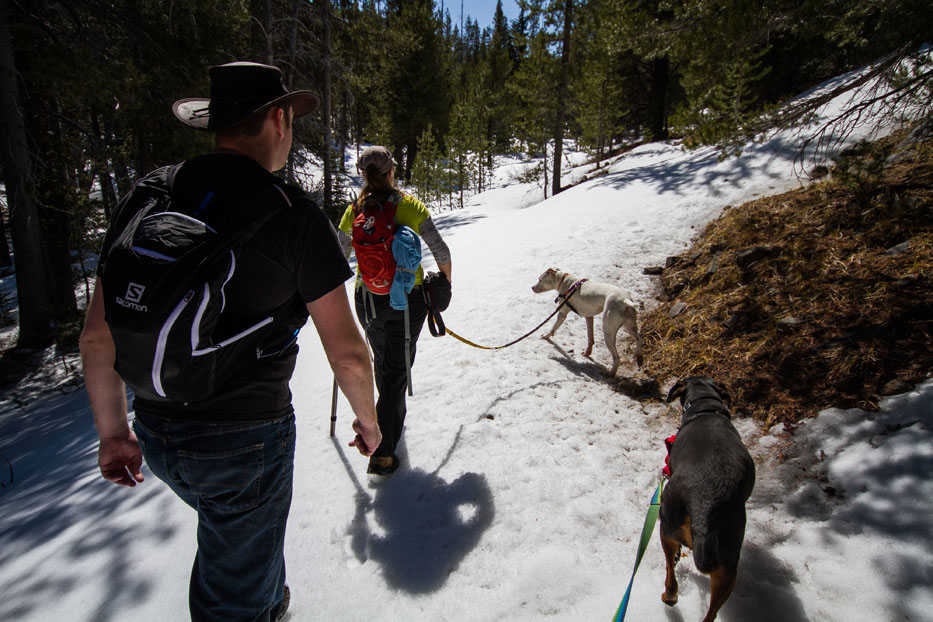KLAMATH FALLS, Ore. (AP) — Exploring the endless trails the Klamath Basin has to offer is made even more enjoyable when your faithful companion, your dog, is along for the journey, too.
Before you head out over mountains and across streams, it’s important to know the rules, expectations, limitations and safety precautions necessary for a fun experience.
Before heading out on any hike, check the regulations for that wilderness area or park.
National parks don’t allow dogs on trails, including Crater Lake National Park. Other areas like the Mountain Lakes Wilderness Area limit group sizes to 10 heartbeats.
Most areas require leashes, but even with a leash, your dog should be familiar with other people or dogs. Jerry Ingram, previous owner of the Ruff House, said the first step is good training, especially if leashes aren’t required.
Whether it’s a run-in with another family, a mountain biker or a mountain lion, your dog needs to return when called. Tasha Tabarez, new owner of the Ruff House, said a good call back is essential so your pet doesn’t get lost when off a leash.
If your pooch is easily distracted or doesn’t listen perfectly, it’s recommended to keep them on a leash at all times. When taking your dog on its first few hikes you may want to consider lesser known trails or going during the off-season to avoid other people.
Limitations
Knowing your dog’s limits is important to keep him or her from reaching dangerous levels of exhaustion. An older or less fit dog might be better off in the local park for a short walk instead of climbing mountains.
If your dog is ready for the long haul, you might consider letting them carry a few things. But remember, they aren’t pack mules. As Ingram notes, “Dogs aren’t really designed to carry a lot of weight.”
To get your four-legged friend comfortable with a pack, break it in on shorter walks around town. When they’re comfortable with the pack for long periods of time, start adding weight.
Pack it light at first, but you should never exceed about a third of the dog’s weight. Depending on the size of your companion this means they could carry their food and water and maybe a little extra.
If you’re backpacking, overnight sleeping arrangements and rain scenarios need to be taken into account as well.
Some dogs are small enough to fit into your sleeping bag, but others might not be. Dogs also don’t have the option to take off wet clothes for the night so finding a way to dry your dog in the rain can make a difference when temperatures drop.
On the flip side, when hiking on a scorching summer day, it’s easy for a dog to overheat. Rhona Snipes and Serena Stalcup from the Hot Paws Spa recommend a cooling vest. “You soak it in water and they wear it like a life jacket to keep them cool,” Snipes said.
Safety
Keeping your dog hydrated is the number one overlooked aspect of hiking, experts agree.
Dogs dehydrate faster than humans and, because they don’t sweat, overheating can compound their exhaustion. Keeping more than enough water for yourself and your dog is the first thing you should plan for before heading out the door.
If you come across rivers or lakes don’t let your dog start drinking. Bacteria and algae can make your pooch very sick.
Keep an eye on their paws as well. In the winter, boots are great to keep their paws off the snow. Snipes recommends paw creams for protection and healing. Tabarez said she uses a wax for paws called Musher’s Secret that helps on sharp rocks and cold snow.
Stalcup said flea and tick treatments can help, especially if maneuvering through brush or tall grasses. She also said getting your dog’s feet shaved can help against foxtails.
While rare, encounters with wildlife can happen and should be taken seriously. Rattlesnake vaccines may be available from veterinarians and could be the difference between life and death if your dog gets bitten. According to Stalcup, the vaccine slows the venom’s effect and provides more time to get your dog to the vet.
Along with a basic First Aid kit for yourself, it’s a good idea to keep a vet wrap and disinfectant handy, too.
There are endless scenarios to prepare for hiking with dogs, and this is just a basic introduction. Once on the trail, you’ll learn other tips and tricks.
Talk to your veterinarian, trainer, neighbors and friends to find out more about how to safely explore the outdoors with your pet.

